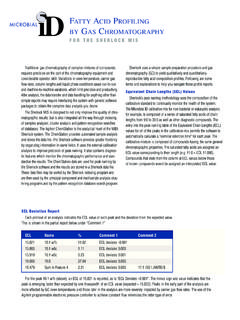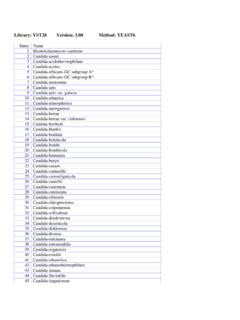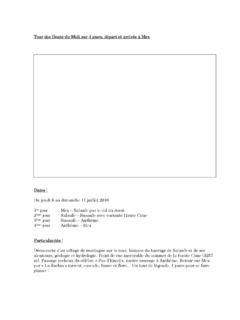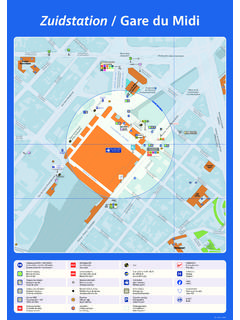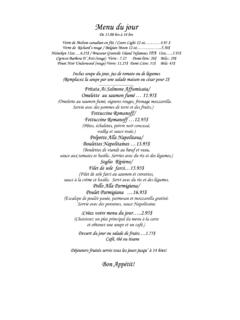Transcription of Myron Sasser Last Revised July 2006 Bacterial ...
1 INTRODUCTIONFor many years, analysis of short chain fatty acids (volatilefatty acids, VFAs) has been routinely used in identification ofanaerobic bacteria. In numerous scientific papers, the fattyacids between 9 and 20 carbons in length have also beenused to characterize genera and species of bacteria, especiallynonfermentative Gram negative organisms. With the adventof fused silica capillary columns (which allows recovery ofhydroxy acids and resolution of many isomers), it hasbecome practical to use gas chromatography of whole cellfatty acid methyl esters to identify a wide range of ACIDS FOUND IN BACTERIA More than 300 fatty acids and related compounds havebeen found in bacteria analyzed in the MIDI Research andDevelopment Laboratory. The wealth of information containedin these compounds can be estimated by considering notonly the presence or absence of each acid, but also by usingthe data in quantitative fashion.
2 While the theoretical ability todifferentiate among 2300different combinations is not practicaldue to the nonrandom distribution within groups of bacteria,the huge number of fatty acids creates great naming powerfor the Sherlock MIS uses fatty acids 9-20 carbons in length. Thepeaks are automatically named and quantitated by the chain acids predominate in some Gram positivebacteria, while short chain hydroxy acids often characterizethe lipopolysaccharides of the Gram negative bacteria. Thestructures of a few of these compounds are shown in Figure 1In this note, all compounds will be referred to as fatty acids,even though the actual compounds may be aldehydes, hydro-carbons, or dimethyl acetals, and are typically analyzed as themethyl esters. The system of naming used in this note is tocount carbons from the omega end ( opposite the carboxylend) and to indicate the other structures where known.
3 Thevarious combinations of features may result in very largenumbers of fatty acids. Though most fatty acid identificationshave been confirmed by mass spectroscopy, some are stilllisted as unknown or with a letter designating that the doublebond position and/or configuration has not been of Fatty AcidsBacterial Identification by Gas ChromatographicAnalysis of Fatty Acid Methyl Esters (GC-FAME)Technical Note #101 Myron SasserMay 1990 Last Revised July 2006 CULTURING OF THE BACTERIAThe most stable and reproducible cellular fatty acid profile isachieved by carefully regulating the growth scientific papers have reported the effects of growthtemperature and of different growth media on Bacterial fattyacid composition. To minimize these variables, a specifictemperature and growth medium have been chosen for eachlibrary.
4 For example, most aerobic bacteria will grow well onTrypticase Soy Broth Agar (TSBA), which consists of 30gTrypticase Soy Broth and 15g of agar (BBL). Those aerobicbacteria, which will not grow well on TSBA, are grown on themedium which would be most commonly used for theirgrowth in the laboratory ( Legionellaon buffered charcoalyeast extract, and Haemophiluson chocolate agar). The tem-perature chosen for the TSBA database was 28 C to enablegrowth of a wide range of organisms. A separate database,CLIN, uses 35 C and blood agar (Trypticase Soy base) as thestandards, with specialized media for specific 1 Sherlock Standard LibrariesFor the anaerobic bacteria, the plate-based dataset uses cultures grown at 35 C on brain-heart infusion with supple-ments. A database containing more than 800 entries wasdeveloped (by the VPI Anaerobe Lab) using overnight cultures from peptone-yeast extract-glucose effect of age is minimized in the broth cultures by harvesting at a given turbidity.
5 When using plate cultures, the growth period is 24 hours for aerobes and 48 hours foranaerobes. Standardization of physiological age of culture isobtained by choice of sector from a quadrant streak on theplate (Figure 2). Slow growing organisms may be incubatedfor the period of time necessary to obtain adequate 2 Quadrant StreakREAGENTSFour reagents are required to cleave the fatty acids from lipids:Reagent 1, Saponification 45g sodium hydroxide,150ml methanol, and 150ml distilled water. Dispensingthrough use of an autopipet assures reproducibility andallows for large numbers of assays in a 2, Methylation 325ml certified acid and 275ml methyl alcohol. This drops thepH of the solution below and causes methylation (for theincreased volatility in a partially polar column) of the fattyacid. The fatty acid methyl ester is poorly soluble in theaqueous phase at this 3, Extraction 200ml hexane and 200ml methyltert-butyl ether.
6 This will extract the fatty acid methyl estersinto the organic phase for use with the gas 4, Sample Cleanup sodium hydroxidedissolved in 900ml distilled water. This procedure reducescontamination of the injection port liner, the column, and thedetector. More than 10,000 analyses can be performed on acolumn prior to needing any maintenance. SAMPLE PROCESSINGThe five steps to prepare GC ready extracts are illustratedin Figure A 4mm loop is used to harvest about40mg (2mm or 20mg wih Rapid and Sensi Methods)of Bacterial cells from the third quadrant (second or first quadrant if slow growing) of the quadrant streaked plate. The cells are placed in a clean 13x100 culture of Reagent 1 is added to eachtube containing cells. The tubes are securely sealed withteflon lined caps, vortexed briefly and heated in a boilingwater bath for ca.
7 5 minutes, at which time the tubes arevigorously vortexed for 5-10 seconds and returned to thewater bath to complete the 30 minute The cooled tubes are uncapped, 2mlof Reagent 2 is added. The tubes are capped and brieflyvortexed. After vortexing, the tubes are heated for 10 1minutes at 80 1 C. (This step is critical in time andtemperature.)Extraction Addition of of Reagent 3 tothe cooled tubes is followed by recapping and gentletumbling on a clinical rotator for about 10 tubes are uncapped and the aqueous (lower)phase is pipetted out and Wash About 3ml of Reagent 4 is added tothe organic phase remaining in the tubes, the tubesare recapped, and tumbled for 5 minutes. Followinguncapping, about 2/3 of the organic phase is pipettedinto a GC vial which is capped and ready for FACTORSThe Sherlock MIS Software can only be used with the Agilenttechnologies 5890, 6890 or 6850 gas chromatographs.
8 The Sherlock System s unique configuration is designed for optimal analysis of Fatty Acid Methyl Esters by gas 2 Column A 25m x phenyl methyl siliconefused silica capillary column has both the chromatographicperformance and the column lifetime desired for routineanalysis of Bacterial extracts. The column is required to havemore than 4,000 theoretical plates per meter for peaks with k = 7 to 9. Since the stationary phase is cross linked to thesilica tube, there is less noise and drift during temperatureprogrammed Chromatograph The temperature program rampsfrom 170 C to 270 C at 5 C per minute. Following theanalysis, a ballistic increase to 300 C allows cleaning of thecolumn during a hold of 2 minutes. The flame ionizationdetector allows for a large dynamic range and provides goodsensitivity. Hydrogen is the carrier gas, nitrogen is the makeup gas, and air is used to support the Use of an autosampler allows the system tobe operated unattended for up to 2 days at a time.
9 Samplesare logged into the computerized sample table and all sampling (including STAT samples) is done The electronic signal from the GC detector ispassed to the computer where the integration of peaks is performed. The electronic data is stored on the hard disk andthe fatty acid methyl ester composition of the sample is compared to a stored database using the Sherlock patternrecognition 3 Sample PreparationCALIBRATION AND PEAK NAMINGThe Sherlock MIS uses an external calibration standarddeveloped and manufactured by Microbial ID, Inc. Thestandard is a mixture of the straight chained saturated fattyacids from 9 to 20 carbons in length (9:0 to 20:0) and fivehydroxy acids. All compounds are addedquantitatively sothat the gas chromatographic performance may be evaluatedby the software each time the calibration mixture is hydroxy compounds are especially sensitive to changesin pressure/ temperature relationships and to contaminationof the injection port liner.
10 As a result, theses compoundsfunction as quality control checks for the systemRetention time data obtained from injecting the calibrationmixture is converted to Equivalent Chain Length (ECL)data for Bacterial fatty acid naming. The ECL value foreach fatty acid can be derived as a function of its elutiontime in relation to the elution times of a known series ofstraight chain fatty Rtxis the retention time of x; Rtnis the retention timeof the saturated fatty acid methyl ester preceding x; Rt(n + 1)is the retention time of the saturated fatty acid methyl estereluting after , it is possible, by comparison to the external standard,to compute the ECL value for each compound following ananalysis. The GC and column allow windows to be set ECL unit wide giving great precision in resolution ofisomers. After naming the peaks in an unknown sample,Sherlock compares the ECL values for the most stableseries ( saturated straight chain or branched chain acids)to the peak naming table s theoretically perfect values andmay recalibrate internally if sufficient differences are feature allows the system to be run for up to two daysunattended without worrying about drift between Sherlock libraries consist of more than 100,000 analysesof strains obtained from experts and from culture cultures were collected from around the world to avoidpotential geographic bias.
